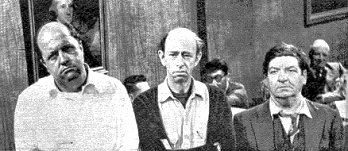
Pictured are character
actors portraying hapless
defendants on an episode
of KTLA's
"Night Court"
in 1958.
Thursday, June 5, 2003
Page 15
REMINISCING (Column)
KTLA’s ‘Night Court’: Not to Be Taken Seriously
By ROGER M. GRACE
“Night Court”—not the ’80s sitcom, but the earlier semi-serious series that starred veteran actor Jay Jostyn as a cantankerous judge with a mellow streak—was a show that was strictly for entertainment. Actual lawyers did not appear on it; there was no technical advisor. Faithful depiction of proceedings in an arraignment court was simply not its objective.
The program started April 18, 1958 as a local show aired weekly on KTLA, Channel 5. The “TV Guide” listing for the seminal session explained: “This half hour program makes use of both character actors and people off the street to portray those brought into night court.”
“Night Court” soon abandoned the use of amateurs. Also, it became an hour program.
|
|
Pictured are character
actors portraying hapless |
|
Like other courtroom simulation shows that were cropping up in the wake of the success of “Traffic Court,” it became a winner in the ratings, resulting in two more make-believe courtrooms being opened at KTLA. “Municipal Court” was presided over by actor Charles Irwin, who later portrayed a judge on 11 episodes of CBS’s “Perry Mason.” “Youth Court” featured James Russell Lane as the jurist, though his gruff manner and appearance seemed to better qualify him for a role as a bouncer in a saloon.
As the 1960s approached, producers of some non-network shows were feeling out how far they could stray from the rigid moral standards that had governed TV from the start. Crossing the line took place on all three of KTLA’s courtroom shows. On each edition of “Municipal Court,” there was almost always at least one prostitution case called. And, typically, some shocking fact relating to aberrant conduct would be revealed on “Youth Court,” causing Lane to adopt a stunned expression, just as there was a break for a commercial.
|
|
|
|
Here are ads for KTLA courtroom shows in the late 1950s. |
|
“Night Court” did deal with some cases involving indecent exposure, adultery, and so on, which would have been taboo back then on the networks. However, it was, to a large extent, a light-spirited show. Offering numerous cases with whimsical fact situations, featuring hammy actors portraying offbeat characters, it was the least serious of the courtroom simulation shows on TV. Some of the scenes were played almost for laughs.
So far was the show from accuracy that its deviations were near-comical. As I recall one show (and after 45 years, this rendition might well be faulty), a man was charged with attempting to break into a car. He explained to the judge that it was his own car, but he had misplaced the keys. Well, that was understandable, the judge allowed, and dismissed the case. Later into the program, the bailiff brought the man back into court, announcing to the judge that he caught him breaking into a car in the parking lot. His honor realized he had been bamboozled a short time before, and sentenced the man to prison for having committed perjury.
I’ve recently viewed some episodes of “Night Court” that were equally off base. Actually, these episodes weren’t from the original series—videotapes shown only in L.A.—but from a syndicated version that came on its heels.
When Paramount, which then owned KTLA, decided to peddle the show to other markets, it had the scripts performed anew (again with Jostyn as the judge), this time on film. The black-and-white films were syndicated under the name, “Night Court, USA,” with the proceedings impliedly taking place right there in the viewer’s own city, wherever it might be. The Penal Code sections weren’t those of any actual jurisdiction, nor were the legal procedures.
Five complete episodes of “Night Court, USA” are downloadable from a website, though you have to pay a $12 fee for a one-month membership to acquire those shows (and others in the inventory).
Watching the “Night Court, USA” episodes is a “hoot,” despite the shoddy video quality. The files, in “.ram” format, feature faltering, jerky pictures.
The hokeyness would not, itself, render these old shows worth viewing. There’s another element: the personality and acting of Jostyn, who effectively portrayed the wise but crusty judge. Jostyn, by the way, had the lead role on radio’s “Mr. District Attorney” (available on the Internet in MP3 format) and also starred in a live ABC-TV version of the show in 1951-52.
Next week: more on “Night Court, USA.”
Copyright 2003, Metropolitan News Company